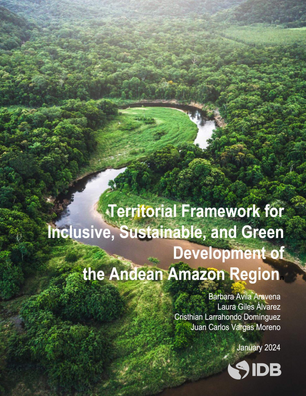Territorial Framework for Inclusive, Sustainable, and Green Development of the Andean Amazon Region
Date
Jan 2024
The Amazon is one of the most complex and richest resources in the world. With its 5.5 million km2 of dense tropical forest and 7.9 million km2 of river basin, it is one of the most biodiverse and richest regions on the planet. In Bolivia, Colombia, Ecuador, Peru and Venezuela - the Andean Amazon Region (AAR) these 2.7 million km2 are also home to approximately 24.7 million people, including more than 200 known indigenous groups.
Despite its advantages and the efforts invested, the AAR, its territory and population, continue to be exposed to a number of social, economic and conservation challenges. These challenges have not allowed a responsible use of this rich and diverse natural asset, contributing to a rapid process of deforestation, high levels of poverty and exclusion, and low levels of productivity. The question arising from these challenges is: How to promote an inclusive and sustainable development model that at the same time protects the environment and the natural capital of the AAR?.
In order to respond to this question, this study conducts a development gap analysis for the AAR. The methodology uses a combination of quantitative and qualitative techniques to identify and measure development gaps in the territory, both at the sectoral and multisectoral levels, and proposes an intervention model based on networks and nodes. The analysis is based on the premise that development models in this region should focus efforts on three major areas that will make it possible to address the internal and external challenges of each country in a focused and efficient manner, leading to the closing of development gaps: 1. Taking responsible advantage of existing wealth, including the millenary knowledge of its population and territories; 2. Protecting the environment and natural resources; 3. Promoting an inclusive and green productive model.
The results show that 85.6% of the population and 94% of the territory of the study experience at least one development gap. Regarding the area affected, gaps in access to drinking water, access to primary and secondary education in rural areas, and investment in green and inclusive activities are the most severe, involving 45.9%, 45.2% and 52.1% of the area, respectively. Whereas gaps related to investment in climate resilience, access to power substations, and investment in green and inclusive activities affect the largest number of people: 54%, 41.9% and 35.7% of the population, respectively.
Despite its advantages and the efforts invested, the AAR, its territory and population, continue to be exposed to a number of social, economic and conservation challenges. These challenges have not allowed a responsible use of this rich and diverse natural asset, contributing to a rapid process of deforestation, high levels of poverty and exclusion, and low levels of productivity. The question arising from these challenges is: How to promote an inclusive and sustainable development model that at the same time protects the environment and the natural capital of the AAR?.
In order to respond to this question, this study conducts a development gap analysis for the AAR. The methodology uses a combination of quantitative and qualitative techniques to identify and measure development gaps in the territory, both at the sectoral and multisectoral levels, and proposes an intervention model based on networks and nodes. The analysis is based on the premise that development models in this region should focus efforts on three major areas that will make it possible to address the internal and external challenges of each country in a focused and efficient manner, leading to the closing of development gaps: 1. Taking responsible advantage of existing wealth, including the millenary knowledge of its population and territories; 2. Protecting the environment and natural resources; 3. Promoting an inclusive and green productive model.
The results show that 85.6% of the population and 94% of the territory of the study experience at least one development gap. Regarding the area affected, gaps in access to drinking water, access to primary and secondary education in rural areas, and investment in green and inclusive activities are the most severe, involving 45.9%, 45.2% and 52.1% of the area, respectively. Whereas gaps related to investment in climate resilience, access to power substations, and investment in green and inclusive activities affect the largest number of people: 54%, 41.9% and 35.7% of the population, respectively.




